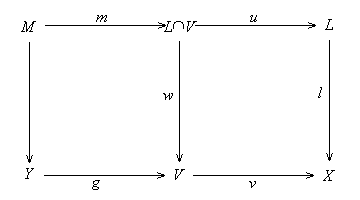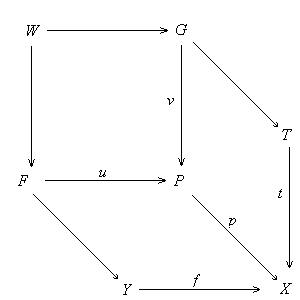|
Let A be a strict coherent analyitc geometires. Proposition 5.5.1. (a) Suppose W Proof. Since any proper strong subobject is contained in a proper
regular subobject, and any proper regular subobject is an intersection
of proper finitely cogenerated regular subobjects by (4.1.3),
it suffices to prove the assertion for a proper finitely cogenerated regular
subobject W. First we note that there is a prime V of X
such that any analytic neighborhood U of V is not contained
in W. Otherwise W contains an analytic cover {Ui}
of X, which is not the case as the category is strict, therefore
X is the colimit of {Ui Proposition 5.5.2. An object is reduced iff each of its localization is reduced. Proof. Suppose X is reduced. By (3.1.3.e)
analytic subobjects of X are reduced. Any localization of X
is a cofiltered limit of analytic subobjects of X, thus is reduced
by (5.1.5.b).
Proposition 5.5.3. A map f: Y --> X is epic iff its pullback along any localization of X is so. Proof. The pullback of any epi along a localization is epic as
any localization is coflat.
 Proposition 5.5.4. Suppose f:
Y --> X is a mono.
Proof. (a) Suppose P Proposition 5.5.5. Suppose f:
Y --> X is a map.
Proof. (a) If Spec(f) is not surjective we can
find a residue P --> X which does not factors through f,
then P --> X is disjoint with f, thus f is not unipotent.
 Proposition 5.5.6. Any unipotent local isomorphic mono f: Y --> X is an isomorphism. Proof. First note that Spec(f) is bijective by (5.5.4) and (5.5.5). Let Z be the coproducts of all localization lP: YP --> Y and let z: Z --> Y be the map induced by lP, then z is an epi by (5.5.1.b). Since f is a local isomorphism and Spec(f) is bijective, Z is also naturally the coproducts of localizations of X with fz: Z --> X as the canonical map. Thus fz is epic by (5.5.1.b), which implies that f is epic. Since finitely copresentable objects form a strong generating set of A, to see that f is an isomorphism, it suffices to prove that any map t: Y --> C from Y to a finitely copresentable object C factors through f. Suppose p: YP --> Y is a localization of Y at a prime P. Since f is a local isomorphism, fp: YP --> X is the localization of X at f+1(P). Thus YP is the cofiltered limit of a collection of analytic neighborhoods Vi of f+1(P) with the maps (fp)s: YP --> Vi. Since C is finitely copresentable, there exists an analytic neighborhood Vs of f+1(P) and a map gs: Vs --> C such that ts ps = gs fsps, where ts: f-1(Vs) --> C, ps: YP --> f-1(Vs) and fs: f-1(Vs) --> Vs are the induced maps. Since C is finitely copresentable and YP is the filtered limits of open analytic neighborhood of P, and f-1(Vs) is one of such analytic neighborhood, there is a small analytic neighborhood UP contained in f-1(Vs) such that the restrictions of ts and gs fs on UP are the same, denoted this restriction by tP . We have proved that for any prime P we can find a small open neighborhood UP of P such that the restriction of t on UP can be factored through the restriction of f on UP. Since the analytic category is strict, these factorization can be glue together to obtain a global factorization for t by f. Proposition 5.5.7. A mono is a local isomorphism iff it is a fraction. Proof. Suppose u: U --> X is a local isomorphic
mono. Any unipotent pullback of u is a unipotent local isomorphic,
therefore is an isomorphism by (5.5.6). Thus u
is normal. So we only need to prove that u is coflat. Since the
class of local isomorphisms is closed under pullback, it suffices to prove
that u is precoflat. Suppose t: T --> X is an epi
and r: Z --> U, s: Z --> T is the pullback
of f and t. For any localization g: G --> U
the map r-1(U) --> U is epic because it
is the pullback of the epic map t along the localization ug:
G --> X. This shows that if r factors through a strong mono
w: W |